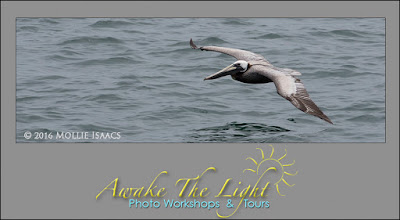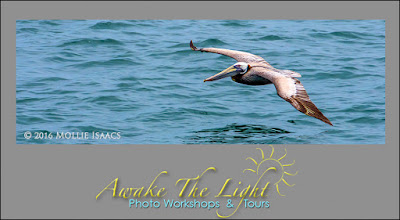Tuesday, June 28, 2016
Birds Of A Feather
Photographing birds is great fun, and can be very exciting. Of course it can also be pretty darned difficult to get sharp images when they flit past you at lightning speed. So there are times when photographing calm, stationary birds is a nice change of pace.
A flock of captive flamingos was enjoying their water hole and generally moving fairly slowly. It gave me time to study their feathers and look for shapes and swirls that would translate well to an abstract image.
There was nice light on this bird, creating highlights and shadows, and providing a three-dimensional look to the feathers. As photographers we live and die by the light. Great light helps us make great images.
Regarding composition, the swirling feathers comprising the bottom half of the image create a curving base that brings the eye up into the flatter feathers along the bird's back. There is a slight variation of color in the feathers, and hidden under a few of them are lovely patches of strong pink tones.
TECHNICAL DATA
Shutter Speed 1/1000 sec. Aperture 7.1. ISO 400. Canon 400mm f/5.6L lens on Canon 5D Mark III body. Handheld.
TODAY'S QUOTE: "There is no abstract art. You must always start with something. Afterward you can remove all traces of reality." --Pablo Picasso
Wednesday, June 22, 2016
A Rose By Any Other Name
Roses are beautiful both in color and shape. When you look carefully at a bed of rose bushes, you will find many different variations of shapes. This one had a lovely spiral at the center, and sweeping petals surrounding it.
The color was a lovely soft peach, and that was going to be the version for today's blog. But when I looked at it more carefully, I thought that perhaps it would look softer and more dimensional in black and white. So I began experimenting with it in Lightroom.
Sure enough, this black and white version really appealed to me. It was a quick and easy transition from color to black and white in Lightroom. I used the B&W controls in the "HSL / Color / B&W " section in the Develop module. When you click on B&W in the heading, the image is converted to black and white. But that is just the beginning. By moving the color sliders in that box, you can control the lightness or darkness of any colors in the original image. Lightroom still "sees" the image in color, even though we see it in black and white.
I wanted a very light, ethereal look and because the predominant color was peach, moving the red slider lightened the rose nicely. I also reduced Clarity to -30 to create a softer look. A few finishing touches with the Whites, Blacks, Highlights, and Shadows sliders, and the final image was created.
TECHNICAL DATA
Shutter Speed 1/1250 sec. Aperture f/2.8. ISO 200. Lens: Canon 100mm f/2.8L IS macro. Camera: Canon 7D Mark II. Handheld.
TODAY'S QUOTE: "A rose by any other name would smell as sweet." --William Shakespeare
Thursday, June 16, 2016
Mellow Yellow
The Creative and Impressionist Flowers photo workshop ended today, and what a workshop it was! We saw some exquisite flowers at Longwood Gardens in Pennsylvania, including gorgeous roses. The participants created some beautiful images and quickly got the hang of new techniques like shallow depth of field and back button focus.
This yellow rose sported some water droplets left over from a morning rain, which added to the beauty of the undulating petals. Shooting straight down on the center of the flower created a circular main subject, while the curving outer petals provided support and added interest.
When doing macro photography of flowers, shallow depth of field enhances the feeling of softness and dimensionality. Not all parts of the image have to be razor sharp, but it helps to have something important sharp, like the small round center in this case.
I use autofocus, and set only one focus point visible in the center of the viewfinder. That enables me to quickly focus on the area I want sharp, knowing that the autofocus will lock onto that exact area. It is quick, easy, and almost foolproof.
TECHNICAL DATA
Shutter Speed 1/1250. Aperture f/4. ISO 400. Lens: Canon 100mm macro f/2.8L IS. Camera: Canon 7D Mark II. Handheld.
TODAY'S QUOTE: "If we could see the miracle of a single flower clearly, our whole life would change." --Buddha
Saturday, June 11, 2016
Power at Your Fingertips
 |
| BEFORE |
 |
| AFTER |
It's time once again to demonstrate the power of image optimization software. If you are not using some sort of software to extract the latent beauty in your images, you are missing out on a very important element of your photography.
My software of choice is Lightroom, probably the most popular and easiest to use of anything out there. I teach Lightroom workshops several times a year, and it is always so gratifying to help someone FINALLY see how nice their photography really is. Often people are frustrated because their images lack punch or rich colors. Well, you can improve most images in just a matter of minutes, and the software is VERY easy to learn and to use. You do not have to be a computer expert, and you do not even have to like using your computer very much.
This image was brought from being gray and dull to being colorful and detailed in just a matter of minutes. It took only 7 quick changes in Lightroom to get from the Before image to the After image. Click on each image to see it larger, and you will see all the detail brought out in the head, and the color in the wings and the water.
Lightroom uses sliders to increase or decrease different aspects of an image. For this image, I did the following:
1. Cropped the image.
2. Moved the Shadows slider to the right to lighten the shadows.
3. Moved the Whites slider to the right to brighten them.
4. Moved the Clarity slider to the right 30 points.
5. Used the Brush Tool to pinpoint areas on the head and lighten them.
6. Moved the Saturation Slider to the right to intensify colors.
7. Moved the Noise Reduction "Luminance" slider to the right to +30.
So in under 5 minutes a disappointing image, colorless and lacking in contrast, was made much more interesting and is a more realistic representation of what I actually saw.
If you or your camera club is interested in an In-Depth Lightroom workshop, contact me at awakethelight@charter.net to discuss a small workshop for just your group. These workshops are hands-on, detailed, and filled with a great deal of personalized instruction. Lightroom workshops are generally scheduled from December through March.
TECHNICAL DATA
Shutter Speed 1/1250 sec. Aperture f/10. ISO 400. Lens: Canon 200-400mm f/4L IS with built-in 1.4x extender. Camera: Canon 7D Mark II. Gitzo tripod with Really Right Stuff ballhead and Wimberley Sidekick.
TODAY'S QUOTE: "Learning is a treasure that will follow its owner everywhere." --Chinese Proverb
Tuesday, June 7, 2016
Misty Mood
Adding emotion or mood to an image can be a powerful tool. And mist or fog seems to appeal to nearly everyone. It provides a sense of quiet calm and a bit of mystery. Knowing when to expect misty conditions will help you find good shooting spots.
In general, spring and fall provide the ideal weather conditions for misty mornings. When it is quite cool overnight, but warm during the day, mist or fog will often form in the early morning in low-lying areas and along waterways. But it can burn off quickly once the sun comes up, so you have to make your best guess as to where to be before sunrise.
This shot in Jasper National Park in the Canadian Rockies was made at sunrise along a small lake. There was a slight breeze which moved the mist quickly along the lake surface and the scene was constantly changing. I shot many images as the scene morphed in front of my eyes, and this is my favorite. There is plenty of mist to provide that sense of mystery I mentioned, with a bit of an opening to allow the strong autumn colors to blaze through brilliantly.
To pick the mornings with the best chances of mist or fog, check the long-range weather forecast. Find the days that are predicted to have the coolest nights followed by warm days. Those conditions will set things up for you. The cool air overnight will drop below the warm air layer above, and will sit close to the ground. Then as the day begins, the air temperature will start to warm and the mist formed will rise. It will be a pleasant, quiet time to be out photographing, and with any luck Mother Nature will cooperate to provide a wonderful scene before your eyes.
TECHNICAL DATA
Shutter Speed 1/125 sec. Aperture f/5.6. ISO 3200. Lens: Canon 70-200mm f/4L IS, set at 100mm. Camera: Canon 5D Mark III. Gitzo tripod with Really Right Stuff ballhead and Wimberley Sidekick.
TODAY'S QUOTE: "Every morning is a fresh beginning. Every day is a world made new. This moment - this day - is as good as any moment in all eternity. This is my day of opportunity." --Dan Custer
Thursday, June 2, 2016
Sum-sum-summertime
Summer is coming, and while we have started seeing ads for getting our beach bodies in shape for those itsy bitsy teeny weeny yellow polka dot bikinis, things are a bit different from a photographer's perspective. For us, it means getting our gear ready so we can stroll the beaches or wander through gardens or roam the highways for some wonderful and unique images.
This is a great time of year to be outside in search of fun in the sun. This image was made while walking on the beach on a sunny afternoon. Don't let bright sunlight deter you from shooting. We hear about the magic light of early morning or late afternoon / evening, and it is indeed beautiful light. But there are great shots to be had when the sun is high in the sky as well.
The main thing to be aware of in mid-day sunshine is shadows. They can be very hard-edged, and also can be quite dark. Look for areas where the darkest shadows are not going to interfere with the main subject OR where they become part of the composition. In this shot, because of my position relative to the sun, there are no serious shadows. There is a slight shadow under the bird's wing but it is a tiny part of the image and does not grab your attention.
Two primary elements make this image work. First, it is an example of a decisive moment. It was taken a split second before the water reached the bird. You know that in the next instant the water will move forward and the bird will either walk or fly away. Second, the strong diagonal line created by the white foam creates a leading line and brings your eye directly to the main subject, the bird.
Supporting elements are the bird's reflection, and the combination of the warm-toned sand against the cool-toned water.
TECHNICAL DATA
Shutter Speed 1/800 sec. Aperture f/7.1. ISO 200. Lens: Canon 70-200mm f/4L IS, set at 200mm. Camera: Canon 30D (an oldie but a goodie!). Handheld.
TODAY'S QUOTE: "And so with the sunshine ... I had that familiar conviction that life was beginning over again with the summer." --F. Scott Fitzgerald
Subscribe to:
Posts (Atom)





